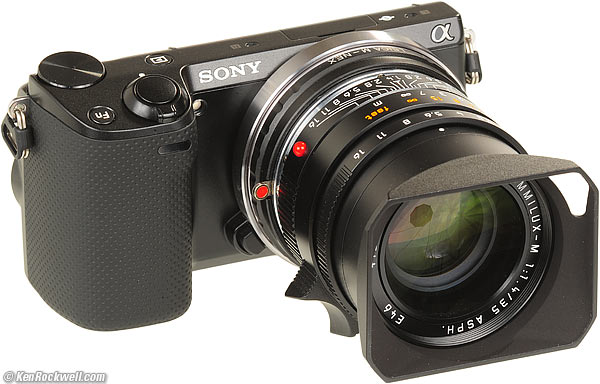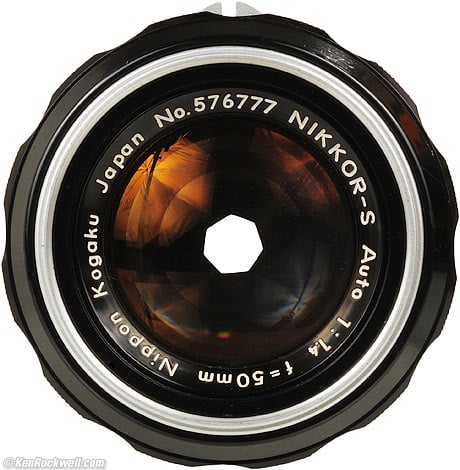Home Donate New Search Gallery Reviews How-To Books Links Workshops About Contact
Lens Adapters
A very bad idea.
© 2013 KenRockwell.com. All rights reserved.
Sony NEX-5R and LEICA SUMMILUX-M 35mm f/1.4 ASPH mit floating element with an adaptor. enlarge. See this LEICA lens compared to the crappy Sony lens.
This free website's biggest source of support is when you use those or any of these links when you get anything, regardless of the country in which you live — but I receive nothing for my efforts if you buy elsewhere. I'm not NPR; I get no government hand-outs and run no pledge drives to support my research, so please always use any of these links for the best prices and service whenever you get anything. Thanks for helping me help you! Ken.
September 2013 Better Pictures Nikon Canon Fuji LEICA All Reviews
See an adapted LEICA lens compared to a crappy Sony lens.
Introduction top
Intro Specs Performance Compared Usage Recommendations More
|
Adorama pays top dollar for your used gear. I use these stores. I can't vouch for ads below. |
Many decades ago lens adapters were popular because cameras and lenses didn't communicate with each other, and because cameras and lenses were all made by different companies anyway.
Today it's foolish to try to adapt different lenses to digital cameras. There is no communication between lens and camera, so it's a royal pain to try to shoot with the Frankensteinian combination, and the results usually aren't as good.
When you use a lens adapter, you sentence yourself to enormous added hassles of losing metering, losing exposure automation, losing data recording, losing autofocus and losing automatic diaphragm operation: you have to remember to close and open the diaphragm by hand for each and every shot!
People quickly learn that you can't really use other brands of lenses on your DSLR or mirrorless camera because of this added inconvenience, and the potential for quality loss when using lenses optimized for different formats just isn't worth it.
LEICA lenses are great when used on LEICA 35mm cameras, but when I compared a $5,000 LEICA SUMMILUX-M 35mm f/1.4 ASPH mit floating element on a Sony NEX-5R with an adaptor versus just using the Sony 18-55mm OSS, the results were about the same after all that effort! The results are similar, and that Sony lens is among the worst 18-55mm lenses I've tested!
Adapt a lens to your digital camera, and it's probably not a zoom, and definitely won't have the shorter focal lengths needed for the smaller digital sensors. Wide-angle 14mm, 18mm and 20mm SLR lenses are much softer than ordinary 18-55mm zooms designed for APS-C cameras when used on APS-C. The SLR ultrawides are much older designs, and had to cover ultrawide angles on full-frame. They aren't as sharp as today's less-expensive standard APS-C zooms.
With lens adapters, you almost always lose the automatic distortion correction, automatic color-shading correction for wide lenses, light falloff correction and lateral color fringe correction done by many cameras with their own lenses. Even if the manufacturer doesn't mention it, most modern digital cameras correct the imperfections of their own lenses, but can't do anything for random lenses mechanically adapted to it.
Autofocus is usually more accurate than attempting to focus an adapted lens manually. The camera's computer can analyze the image for sharpness as it focuses faster and more precisely than you or I squinting at an LCD trying to do the same thing. Even if you can precisely focus a lens manually, you won't be able to apply any spherical-aberration induced focus-shift correction to give better focus at various apertures, again, something often done silently and automatically by modern digital cameras with their own lenses.
It doesn't matter if you can get an Olympus OM lens and a Sony NEX adapter or whatever inexpensively on eBay, because the resulting combination of using an older lens on a digital camera always results in frustration, and the end results are rarely as good as using the correct lens in the first place. Even the crummier modern mirrorless lenses are often optically better than using older top-end SLR or rangefinder lenses because newer lenses use far newer designs which are usually much sharper than what we accepted for use back on full-frame 35mm film. Even cheap modern mirrorless lenses are designed only having to cover a smaller sensor, and are better optimized for them.
When using an adapted lens on a digital camera, you lose more than most people even knew they had.
First off, you have to open and close the diaphragm manually for each shot. If you are shooting the same thing and don't need to refocus, you sometimes can get away with not having to open the lens to refocus.
In almost all cases, there is no electronic communication from the adapter, so you get no EXIF information, either, about the lens or its focal length.
You probably will be able to meter exposure manually, and may or may not get aperture-priority automation — but you'll never get the lens aperture displayed in your finder or in your EXIF data, and never get Professional (P) or shutter-priority (Tv or A) exposure modes.
All in all, even after you go to the effort to shoot with an exotic adapted lens, the results aren't any better. See an adapted state-of-the-art $5,000 LEICA lens compared to a crappy Sony lens.
History
In the beginning of photography in the 1800s, cameras and lenses were each made by completely different companies. You always used a rectangular lensboard that fit the front standard of your bellows-type camera, and in that board was a hole the correct size to fit your lens into the board. Thus your lens was mounted to your camera, and you were done. There was no communication or any kind between lens and camera, and none was needed.
In the 1950s, 1960s and early 1970s, lens adapters were common for 35mm cameras. LEICA's original screw-mount lenses (1932-1960) would work perfectly on LEICA's newest bayonet-mount cameras with the use of a simple metal ring. There was no need for any communication with the camera, other than a coded lug that selected the correct viewfinder frame for each lens' focal length and the rangefinder coupling. LEICA's viewfinders only used three different kinds of lugs, so they made three kinds of screw-to-bayonet adapters, and all was good because the focus cleverly coupled, even with the adapter. Even today, old screw-mount LEICA lenses work perfectly on LEICA's newest cameras because there is no communication needed other than that lug and the focus, both of which couple perfectly.
On SLR cameras from the 1950s though the 1970s, low-performance third-party lenses were popular with many kinds of adapters so that one brand of cheap lens (like Vivitar or Soligor) could be fitted to many brands of camera. The most popular of these adapter systems was called T-mount. You bought a T-mount lens and bought a T-mount adapter ring to fit that lens to your brand of SLR camera.
The T-mount and other lens adapter systems had absolutely no communication between camera and lens. This was bad, because you couldn't just set the focus and aperture and shoot; you needed to open and close the diaphragm manually for each shot! These lenses were called "Preset," because they had two aperture rings: one with clicks to which you would set to your desired shooting aperture, and another marked OPEN and CLOSE which you you flick from OPEN to focus and then to CLOSE to shoot. You'd have to OPEN the lens again to see clearly to focus and compose for the next shot.
Preset lenses were hated in the 1960s because they are such a pain, which is why most SLR lenses have had automatic diaphragms ever since. Automatic diaphragms were a huge thing back in the 1960s, which is why most Nikon lenses of the 1960s were marked AUTO. AUTO meant that the diaphragm snapped-closed automatically as you took the picture, and popped open again all by itself. This was a Godsend, and it's so important that SLR and DSLR lenses have done this ever since, and today we take this for granted. Because automatic diaphragm opening and closing is so important, preset lenses were gone by the 1980s.
1967 Nikon 50mm f/1.4 NIKKOR-S Auto at f/5.6. enlarge.
The gotcha for automatic diaphragms is that every brand of camera has completely incompatible automatic diaphragm systems. One lens cannot be used on more than one kind of camera and retain its automatic diaphragm.
Tamron's Adaptall system of the 1970s attempted some crude mechanical communication of aperture setting and diaphragm opening. Tamron's Adaptall system was clever, but required such complex Adaptall adapters that an adapted lens never worked very smoothly. This was all a ploy by Tamron to make just one lens, and use the cockamamie Adaptall adapters to mount them to each brand. Otherwise, discount lens makers have always had to make somewhat different lenses, one version for each camera brand.
The reason using lens adapters with digital cameras is a bad idea is exactly the same reason it was a bad idea ever since the 1960s: a complete lack of communications between camera and lens. It's a pain to shoot with an adapted lens because everything is as manual as it was in the 1800s, and the lack of electronic corrections probably gives poorer results anyway.
Recommendations top
Yes, it's easy and inexpensive to adapt old lenses to your new camera, but actually shooting with it will be a big pain. Using a lens on an adapter adds many more steps between you and your photo, all of which are taken care of automatically when you use the correct modern lens for your camera. The results with the modern lens will probably be better than with an old adapted lens, too.
If you use an adapter and like it, don't let me discourage you, but if you're asking my advice, adapters make everything much more complicated. Any time I'm thinking about my camera instead of thinking about my subject and what's in my picture winds up as weaker images.
Lens adapters are for tweakers, not for productive photographers.
Help me help you top
I support my growing family through this website, as crazy as it might seem.
The biggest help is when you use any of these links when you get anything, regardless of the country in which you live. It costs you nothing, and is this site's, and thus my family's, biggest source of support. These places have the best prices and service, which is why I've used them since before this website existed. I recommend them all personally.
If you find this page as helpful as a book you might have had to buy or a workshop you may have had to take, feel free to help me continue helping everyone.
If you've gotten your gear through one of my links or helped otherwise, you're family. It's great people like you who allow me to keep adding to this site full-time. Thanks!
If you haven't helped yet, please do, and consider helping me with a gift of $5.00.
As this page is copyrighted and formally registered, it is unlawful to make copies, especially in the form of printouts for personal use. If you wish to make a printout for personal use, you are granted one-time permission only if you PayPal me $5.00 per printout or part thereof. Thank you!
Thanks for reading!
Mr. & Mrs. Ken Rockwell, Ryan and Katie.
Home Donate New Search Gallery Reviews How-To Books Links Workshops About Contact




